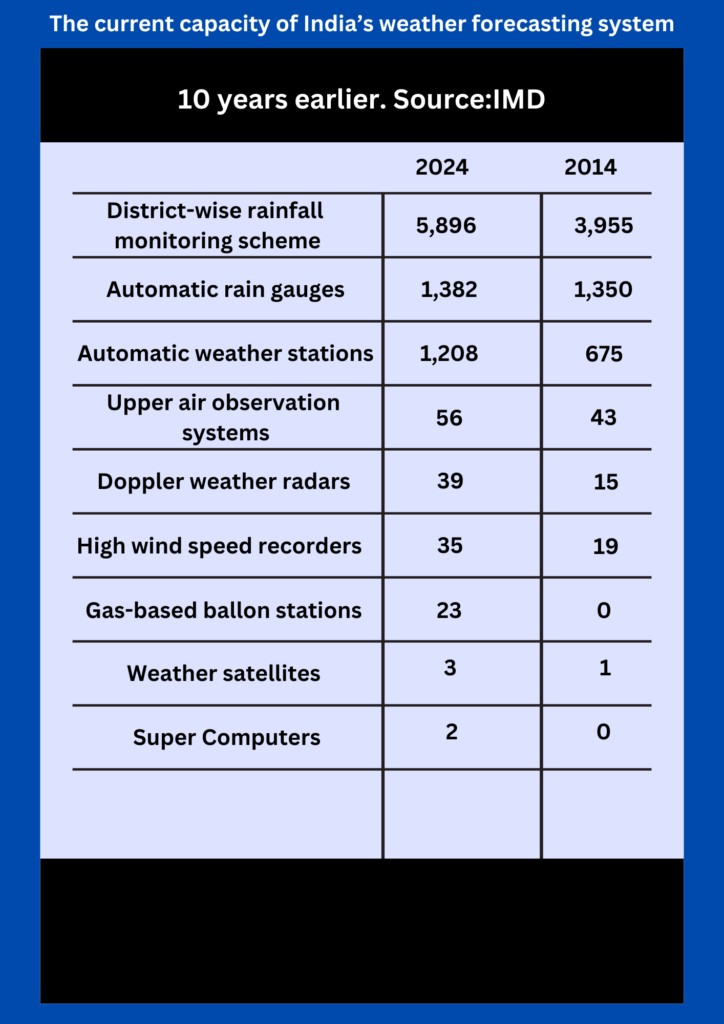IMD Weather Forecasting Accuracy
The Growing Need for Accurate Weather Forecasting
It has been reported that the government intends to enhance the IMD’s current capabilities significantly. Examine the science underlying weather forecasting and the reasons increased accuracy is required in light of the unpredictability brought about by climate change. The primary functions of India’s Met Department, until recently, appeared to be predicting rainfall during the monsoon season and providing information on the highest and lowest temperatures in the country’s four metropolises.
Even while the department was producing a great deal of other worthwhile work, the general public did not seem to find much of it relevant. When accessible, weather services were not highly valued and were not a sought-after resource.
There have been big shifts on both the supply and demand sides of the picture within the last ten or so years. Even among the general population, there is a significant demand for and interest in weather-related information. As well, the India Meteorological Department (IMD) releases a stunning amount of data every day about not only rainfall but also other types of weather phenomena. The accuracy of weather forecasts has improved, leading to a notable increase in public faith in them. Yet, there is still a growing need for even more precise and detailed forecasts, especially given the rise in the frequency of extreme weather events brought on by climate change and the occasionally disastrous consequences they can cause.
IMD’s Journey: From Monsoon Predictions to Cyclone Warnings
Weather forecasting infrastructure, technologies, and expertise are always being updated. As far as improving the long-term monsoon forecasts that are essential for the government’s economic planning, a big push was made in the shape of the Monsoon Mission in 2012. By and by, several further projects were started to enhance the observation network, set up high-end computer systems, use advanced equipment like Doppler radars, and create more accurate computer simulation models.
IMD now has a far better monitoring and observation network, a lot more data, and greater processing capability as a result. As a result, IMD is now able to give far more information geared toward the general public, including heat wave alerts and predictions updated in near real-time.

IMD’s accuracy in predicting cyclones was a major factor in the public’s perception of weather predictions changing significantly. Following Phailin in October 2013, timely and accurate cyclone forecasts paved the way for the development of a dependable reaction and evacuation system, which reduced the previously hundreds of reported fatalities to very few or none.
The IMD gained a lot of credibility as a result of the cyclone early warning system’s effectiveness. Over the past ten years, their long-range monsoon projections have likewise nearly always been accurate. However, predicting severe events—which are becoming more frequent as a result of climate change—as well as hyper-local events—such as a brief period of intense rain in a specific area of a city—has shown to be difficult. The IMD needs to enhance its expertise in this area.
Challenges of Predicting Weather in a Climate-Changing World
Even though the IMD has improved its predicting powers over the past ten years, weather patterns have become more unpredictable due to climate change. Because meteorological phenomena in the tropics are more variable than in regions further from the equator, predicting the weather in these regions is generally more difficult. Large systems that cover vast geographic areas, like cyclones or monsoons, are also very simple to anticipate. It is simpler to predict a widespread heat wave than a localized cloudburst event. In a similar vein, predictable, sudden events are harder to predict than regular, cyclical ones.
Technological Advances in IMD’s Forecasting Capabilities
There are inherent uncertainties in the science of weather forecasting. The uncertainty increases with increasing forecast precision, either in terms of the event’s time window or spatial dispersion. As well, the forecast is likely to be less accurate the earlier it is made. This explains why, during the past ten years, national forecasts for the four-month monsoon season have generally been accurate; while regional and monthly forecasts have been far less so.
As another illustration, IMD has a 97–99% chance of identifying a heat wave at least 24 hours in advance; in contrast, its probability of identifying a heavy rainfall event is less than 80%. Even harder to forecast are extreme weather occurrences. Models struggle to accurately represent events that are predicted to occur just once every 50 or 100 years. These kinds of things now occur frighteningly frequently, frequently setting off tragedies like the fatal landslides that occurred in Kerala last month.
The Future of Weather Forecasting: Hyper-Local Predictions and Beyond
At the moment, IMD can predict weather events across a 12 km × 12 km area. Since this grid is larger than the majority of Indian cities, it is possible to estimate the possibility of rainfall in a given city but not the precise location of the rain. Though the ultimate goal is to obtain hyper-local forecasts for 1 km x 1 km sectors, the IMD has been experimenting with experimental forecasts for 3 km x 3 km grids. These projections can be very beneficial for early warning system creation as well as for individuals in planning their activities.
The Importance of Tailored Weather Models for India
The IMD’s prior improvements have mostly concentrated on improving the infrastructure. Even now, some infrastructure upgrades are necessary, such as the construction of high-resolution earth observation satellites and ocean monitoring systems. Furthermore, Doppler radar coverage is not as good in the country’s northeastern and eastern areas.
However, a significant advancement is needed to create weather models tailored to India that can better comprehend and replicate the country’s characteristics. Existing global models are limited due to the unpredictable nature of weather systems brought about by climate change. One of the primary goals of the proposed update is the construction of such customized models, which would necessitate extensive research and development as well as regional evaluations of climate change.
